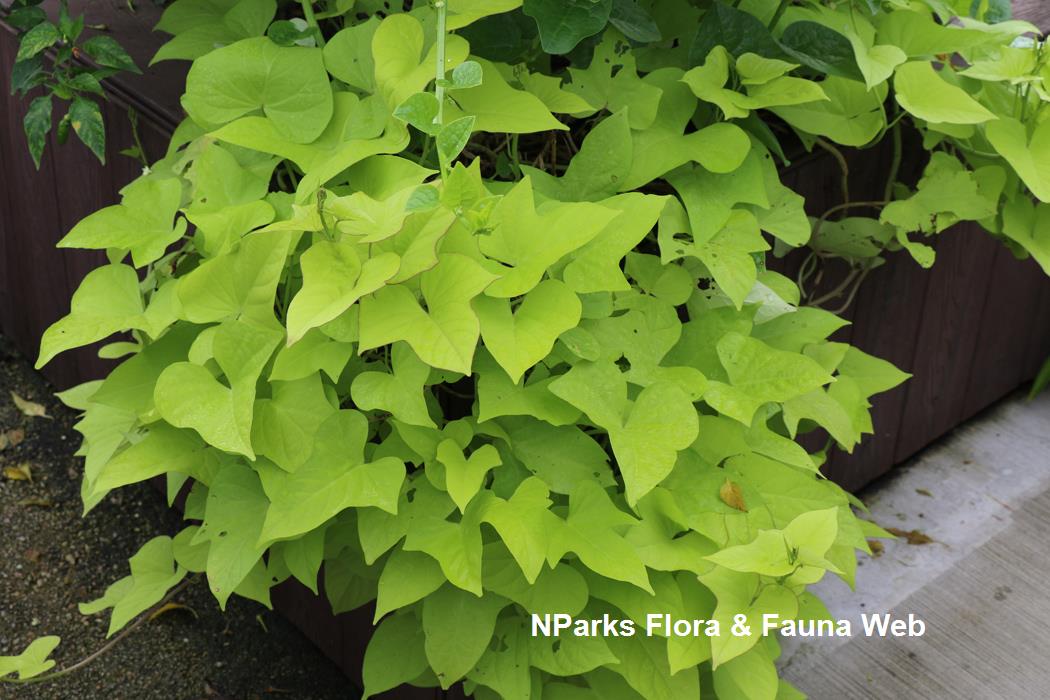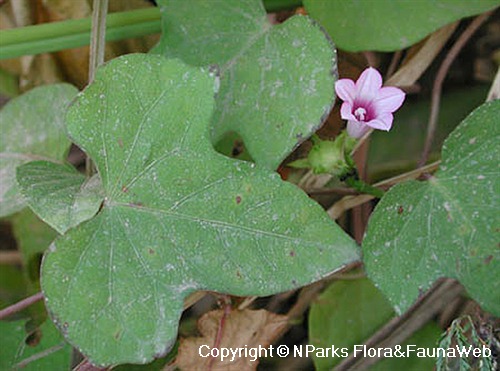
Back
Ipomoea batatas 'Margarita'
| Family Name: | Convolvulaceae |
| Common Name: | Margarita Sweet Potato Vine, Ornamental Sweet Potato Vine |
Name
Classifications and Characteristics
| Plant Division | Angiosperms (Flowering Seed Plants) (Dicotyledon) |
|---|---|
| Plant Growth Form | Climber, Creeper |
| Lifespan (in Singapore) | Perennial |
| Mode of Nutrition | Autotrophic |
| Plant Shape | Irregular |
| Maximum Height | 0.1 m to 0.3 m |
| Maximum Plant Spread / Crown Width | 1.8 m |
Description and Ethnobotany
| Growth Form | Creeping and trailing herbaceous shrub with running stems, spreads indefinitely if allowed to creep along ground surface. Typically 0.2m tall if unsupported, but may climb up to 1.2m with help of a trellis. |
|---|---|
| Foliage | Leaves lobed and somewhat heart-shaped, bright vivid yellow when exposed to full sun, and greenish-yellow in partial shade. Young leaves have reddish margins. |
| Flowers | Trumpet-shaped, resembling morning glory, with delicate pinkish petals, fairly large but not conspicuous amongst yellow foliage. Flowers usually not produced in Singapore, unless under prolonged hot and dry conditions. |
| Fruit | Not observed, as this cultivar is thought to be sterile. |
| Others - Plant Morphology | Ethymology: May be known in the trade under a few cultivar name variations, such as 'Margarite', 'Marguerite' or 'Marguerita', but Royal Horticultural Society (RHS) accepts only 'Margarita' as correct cultivar name. Genus epithet 'Ipomoea' means "resembling a worm", a reference to the twinning habit of the plants in this genus. Species epithet 'batatas' derived from vernacular Caribbean name for sweet potato. |
| Cultivation | Likes well-drained soils and more water during the establishment period. Propagate by stem cuttings or underground tubers. Night beetles may eat round holes in foliage. |
| Ethnobotanical Uses | Food (Fruit or Vegetable) Others: Tubers are edible, but not as tasty as those produced by Ipomoea batatas cultivars used as food crop. |
Landscaping Features
| Desirable Plant Features | Ornamental Flowers, Ornamental Foliage |
|---|---|
| Landscape Uses | Container Planting, General, Flowerbed / Border |
| Thematic Landscaping | Golden Garden, Economic Garden, Naturalistic Garden |
Plant Care and Propagation
| Light Preference | Semi-Shade, Full Sun |
|---|---|
| Water Preference | Moderate Water, Lots of Water |
| Plant Growth Rate | Moderate |
| Rootzone Tolerance | Waterlogged Soils (Drains Site), Easy to Grow, Fertile Loamy Soils, Well-Drained Soils |
| Maintenance Requirements | Moderate |
| Diseases | Night beetles may eat round holes in foliage. |
| Propagation Method | Stem Cutting, Stolon / Runner, Storage Organ |
Foliar
| Foliage Retention | Evergreen |
|---|---|
| Mature Foliage Colour(s) | Yellow / Golden |
| Mature Foliage Texture(s) | Smooth, Glossy / Shiny |
| Young Flush Texture(s) | Smooth |
| Foliar Type | Simple / Unifoliate |
| Foliar Arrangement Along Stem | Alternate |
| Foliar Attachment to Stem | Petiolate |
| Foliar Shape(s) | Non-Palm Foliage (Hastate, Palmate) |
| Foliar Venation | Pinnate / Net |
| Foliar Margin | Entire |
| Foliar Apex - Tip | Acuminate |
| Foliar Base | Cordate |
| Typical Foliar Area | Mesophyll ( 45cm2 - 182.25 cm2 ) |
| Mature Foliage Colour(s) Remarks | Lime Green |
Non - Foliar and Storage
| Stem Type & Modification | Herbaceous, Runner / Stolon |
|---|---|
| Root Type | Underground (Fibrous Root) |
| Specialised Storage Organ(s) | Underground (Root Tuber) |
Floral (Angiosperm)
| Flower & Plant Sexuality | Bisexual Flowers |
| Flower Colour(s) | Pink, Purple, White |
|---|---|
| Flower Symmetry | Radial |
| Individual Flower Shape | Trumpet-shaped |
| Flowering Period | Rarely |
| Flowering Opening Time | Daytime |
| Flowering Habit | Polycarpic |
Image Repository
Others
| Master ID | 128 |
|---|---|
| Species ID | 1424 |
| Flora Disclaimer | The information in this website has been compiled from reliable sources, such as reference works on medicinal plants. It is not a substitute for medical advice or treatment and NParks does not purport to provide any medical advice. Readers should always consult his/her physician before using or consuming a plant for medicinal purposes. |









_lowres.jpg)


